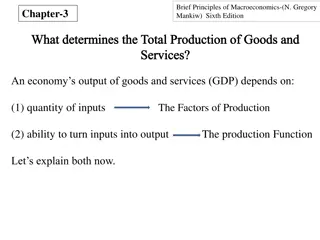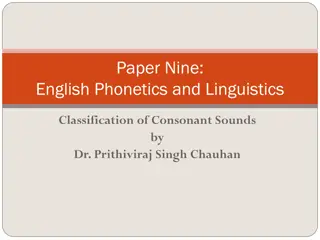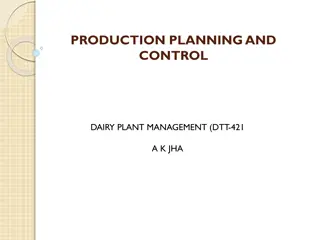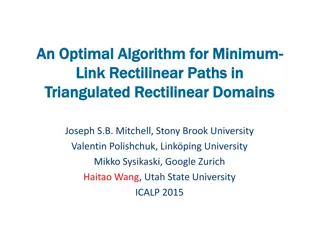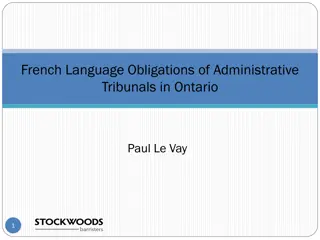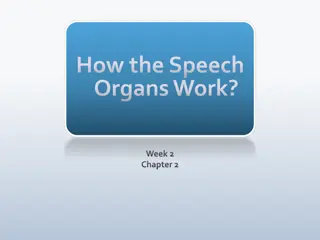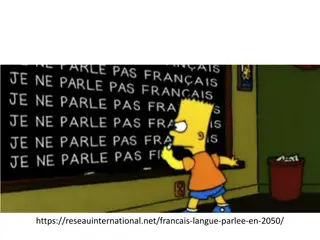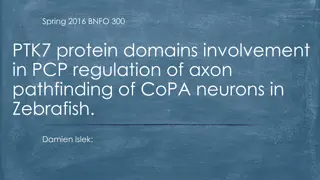Exploring French H-Aspir, Glottal Stop, and Production Planning Domains
The research delves into the variability of the French "h aspir" phenomenon, which includes the presence of glottal stops and its impact on production planning. It discusses cases of both H-aspir-generated glottal stops and glottal stops occurring after unpronounced liaison consonants. The study sheds light on the diachronic variations observed in frequent words experiencing the loss of the H sound. Additionally, it touches upon individual and inter-speaker variability in the pronunciation of words containing the aspirated H. Furthermore, it highlights the absence of empirical studies on H-generated glottal stops and the uncertainties regarding the contexts favoring or disfavoring their occurrence.
Download Presentation

Please find below an Image/Link to download the presentation.
The content on the website is provided AS IS for your information and personal use only. It may not be sold, licensed, or shared on other websites without obtaining consent from the author. Download presentation by click this link. If you encounter any issues during the download, it is possible that the publisher has removed the file from their server.
E N D
Presentation Transcript
French H aspir, glottal stop and production planning domains R seau Fran ais de Phonologie Porto 7-9 juin 2022 Tobias Scheer Universit C te d'Azur, CNRS
h aspir regular V-initial petit [t] [a]rbre H-initial petit *[t] [ ]tre (h tre) H blocks liaison H blocks elision /le arbre/ > l'arbre le h tre Cornulier (1981) H is volatile: variation diachronic frequent words tend to lose it inter-individual intra-individual le haricot > l'haricot l'handicap (people involved in handisport) same word has H for some, but not for other speakers same word used with or without H by the same speaker "many people who are supposed to know and obey the norm seem to toss a coin every time, but, when interviewed, have sharp and definitive judgements following what the grammarians say." Cornulier (1981: 203) 2
h aspir-generated glottal stop Dell (1973a: 186, 262 note 85), Tranel (1981: 311), Pagliano (2003: 635), C t (2008: 66) H may generate a glottal stop to its left is optional what's to the left of unclear C+H: only the context after consonants is mentioned, e.g. Mentioned in passing: Dell (1973a: 186, 262 note 85), Encrev (1988: 198ff) mille hiboux V+H: Encrev (1988: 198) mentions cases after V, le hibou only explicit statement that C+H is more conductive for the appearence of a than V+H: "[a] glottal stop may occur before an h-aspir word, in particular when it is preceded by a consonant-final word." Tranel (1981: 310) Mentioned only after C: C t (2008: 66), Pagliano (2003: 635- 637) *V H joli * h tre joli * hibou Encrev & Scheer (2005) C t (2008: 91) 3
h aspir-generated glottal stop after unpronounced LC (liaison consonants) anecdotally noted in descriptions authors take these cases to be especially noteworthy since they are unexpected. Dubois, Jean 1965. Grammaire Structurale du Fran ais. Paris: Larousse. p.33 des [ e ] h ros L on, Pierre R. 1971. Essais de phonostylistique. Paris: Didier. p.75 nous avons [ a ] assum public speech by de Gaulle in 1958 in Alger reading task experiment, eight speakers, three items tested sept Hongrois, tout Hongrois, une hausse goal: study the variability of H (not H-generated glottal stop) C+H (sept Hongrois): LC+H (tout Hongrois): V+H no data Gabriel, Christoph & Trudel Meisenburg 2009. Silent onsets? An optimality-theoretic approach to French h aspir words. Variation and Gradience in Phonetics and Phonology, edited by Frank K gler, Caroline F ry & Ruben van de Vijver, 163- 184. Berlin: Mouton de Gruyter. 8 / 8 5 / 8 occurrences of occurrences of 4
h aspir-generated glottal stop take-home no empirical study exists on H-generated glottal stop we don't know which left context favours / disfavours H-generated glottal stop whether glottal stops also appear with regular V-initial words sept enfants two loci of variation H (variable) (optional) variation + variation = gradience measuring the occurrence of will deliver a continuum there are multiple factors at play that will be difficult to disentangle: presence / absence of H free variation of left context 5
experimental design design speakers pronounce a sequence of words displayed on a screen the audio is recorded and evaluated by a trained linguist for the presence or absence of a glottal stop: auditory evaluation + wave form h ros, hasard, hall d'entr e, hangar, homard, harc lement, hors-la-loi, hareng, harem, h risson, hoquet, hameau, Hollandais, Hongrois, hold-up experiment type H nouns 12 nouns 25 participants 1800 trials (12x25x6 stim groups) H verbs 12 verbs 42 participants 3024 trials (12x42x6 stim groups) ha r, hurler, hanter, harceler, heurter, hacher, hocher, hausser, huer, harponner, h ter, hisser high lexical frequency items (well, "high": H-words are typically infrequent) 7
experimental design nouns un un un un un un X+H CL+H C+H V+H CL+V C+V V+V gros jeune homard joli grand vier sale joli homard homard X+V stimuli groups endroit endroit verbs nous il tu nous il tu X+H CL+H C+H V+H CL+V C+V V+V hochons hoche hoches aimons aime aimes la t te les paules la t te le foot les fraises le cin ma X+V 8
experimental design pre-test probing inter-individual variation of H, i.e. whether the H words really have an H for the speaker. noun: homard stimulus forced choice le homard l'homard both ok don't know the word verb: hocher je hoche j'hoche both ok don't know the word 9
experimental design experiment-induced biases favouring high register, normative production written stimuli "exam" situation instructions this is not an exam, there is no right or wrong pronunciation please speak as naturally as possible, like when you are at home of course, many speakers ignored that or were unable to conform had an over-normative pronunciation tu hurles [z] l'injustice hacked words: overlong, unnatural pauses un sacr hublot un vrai hangar instits I call them instits (instituteurs) and they are removed from the study. 10
Results #1 h aspir
variation regarding h aspir confirmation of the variation mentioned in the literature pre-test (verbs,42 participants) je 3 39 j' 29 0 both ok 10 3 lexical variation nb of Ps chose je /j' /both harceler ha r other verbs anywhere in between inter-speaker variation nb of verbs chosen with je /j' / both je 1 12 anywhere in between j' 10 0 both ok 1 0 P65 P75 other Ps intra-speaker variation pre-test is not reliable: pre-test je hisse j'h te pronunciation vous [z] hissez la voile nous [z] h tons l' ch ance recall Cornulier (1981): they toss a coin on each speech act. P13 P65 12
liaison obligatory liaison obligatory liaison (according to the literature) within the DP DET + noun Adj. + noun des *[z] enfants petit *[t] enfant DET Adj. in noun experiment taux de liaison 100.0% un grand [d] vier (P25) 100.0% 80.0% un gros [z] enjeu (P23) 55.0% 60.0% 250/ 250 40.0% 136/ 246 20.0% 0.0% Adj. + N DET+N Adj.+N DET + N 13
liaison obligatory liaison obligatory liaison (according to the literature) within the DP DET + noun Adj. + noun personal pronoun + verb des *[z] enfants petit *[t] enfant nous *[z] aimons DET Adj. PRO noun + verb experiment taux de liaison 100.0% 100% 100.0% 80.0% 55.0% 60.0% 504/ 504 250/ 250 40.0% 136/ 246 20.0% 0.0% DET+N Adj.+N PRO+V PRO + V DET + N Adj. + N 14
liaison liaison [X Y] no liaison [[X] Y] function words vs. content words always in the same domain: [DET+N] [PRO+V] function words DET, PRO content words Adj. variation: either [Adj.+N] or [[Adj.] N] the variation observed must be due to the syntactic label 15
Results #2 H-generated glottal stop
H-induced glottal stop in order to eliminate the additional factor due to function vs. content words, in what follows, only data from the verb experiment are reported PRO + V makes sure that only phonological factors are at play. 17
H-induced glottal stop rate 60.0% occurr. 23 / 476 164 / 485 taux % 4,8 33,8 khi2 40.0% V + V V + H tu aimes le cin ma tu haches le persil *** 20.0% 0.0% V + V V + H rate 60.0% C + V C + H il aime les fraises il hait les examens 7 / 503 235 / 489 1,4 48,1 40.0% *** 20.0% 0.0% C + V C + H showing that occurs in all left environments, including after V (literature is unclear about that) but more often when followed by H intuition-based literature confirmed yes H generates glottal stops 18
H-induced glottal stop Strong Position occurr. 164 / 485 235 / 489 taux % 33,8 48,1 anova F = 12,37 p = 0,00108 V + H C + H tu haches le persil il hait les examens ** rate 60.0% intuition-based literature confirmed yes the phenomenon is sensitive to the strong position i.e. more glottal stops occur after consonants (C+H) than after vowels (V+H) 40.0% 20.0% 0.0% V + H C + H Strong Position {C,#}__ = we just saw that the internal Strong Position C__ favours H-generated initial Strong Position #__ : elle hache l'oignon these are not H-created where do they come from? word-initial and post-coda 75% glottal stop rate 19
H-independent glottal stops insertion: factors identified 1. 2. right context left context H Strong Position C__ favour insertion question where do the 's come from in absence of these factors? when there is no H when there is no C__ utterance-initially C + V 1,4% V + V 4,8% ##__ 75% 21
H-independent glottal stops answer they are generated by the left edge of a domain. domain-initiality is a third factor in -creation which kind of domain? surely not morpho-syntactic domains (cycles, phases): the morpho-syntactic relation between the items involved does not vary. 22
domains syllabic island term coined by B. Tranel, based on a long tradition in the analysis of H H sets itself apart from the preceding word and refuses intercourse H-words = block syllabification with the preceding word (lexical marking) not morpho-syntactic in kind: morph-synt. has no clue what an H is. Morin (1974: 87f), Schane (1978), Cornulier (1978, 1981), Tranel (1992, 1995) production planning domains production planning windows define the stretch of the linear string for which production is prepared in one go they are variable across speakers, individual speech acts, etc. a number of factors bear on their creation, including morpho-syntactic information semantics (Selkirk's 1984 sense unit) surprise (incongruent meaning causes a boundary) word length and word frequency attention / distraction of the speaker Wagner (2012), Tamminga (2018), Kilbourn- Ceron (2017) and Wagner et al. (2020) 23
domains effect of production planning V + V tu attends planned into one domain [tu attends] attends not domain-initial no planned into two domains [tu] [attends] [attends] is domain-initial 24
interleaving loci of variation is always an effect of the Strong Position both words in the same domain? domain originates in H regular production planning: V + V no yes word 1 [word 2] [word 1 word 2] and recall the two additional loci of variation that need to be counted in: H (variable) (optional) w1 C-final C__ strong position w1 V-final V__V weak position no thus even domain-initially you will never get 100% of : its insertion is optional. post-coda domain-initial 25 Strong Position
Results #3 CL + H = C + H CL are counted even when unpronounced
CL + H rate 60.0% occurr. taux % 33,8 48,1 anova 40.0% F = 12,37 p = 0,00108 V + H tu haches 164 / 485 C + H il hache 20.0% ** 235 / 489 0.0% V + H C + H recall: V + H C + H tu haches il hache weak position V__V Strong Position C__ significantly higher rate will LC + H side with V + H or C + H? LC + H nous [ ua ] hachons phonetically V__V nous / za / hachons lexically C__ 27
CL + H LC + H is like C + H, both are unlike V + H note the disproportion LC +H produces liaison (nous [z] hachons) these cases are counted out rate 60.0% occurr. taux % 33,8 48,1 anova 40.0% F = 12,37 p = 0,00108 V + H tu haches 164 / 485 C + H il hache 20.0% ** 235 / 489 0.0% V + H C + H rate 60.0% occurr. 164 / 485 taux % 33,8 42,2 anova F = 16,556 p = 0,00021 V + H tu haches LC + H nous hachons 137 / 325 40.0% *** 20.0% 0.0% V + H CL + H rate occurr. 235 / 489 taux % 48,1 42,2 anova 60.0% F = 0,641 p = 0,427 C + H il hache LC + H nous hachons 137 / 325 40.0% non-sig. 20.0% 0.0% H-generated insertion is sensitive to any preceding consonant, pronounced or not C + H CL + H 28
CL + H *** same in box plot ** scale: proportion of responses with and without glottal stop proportion = for each speaker, nb of trials with minus nb of trials without (total nb of trials = 12) thus scale +12 to -12. 29 non-significant
Ct, Marie-Hlne 2005. Le statut lexical des consonnes de liaison. Langages 158: 66- 78. C t , Marie-H l ne 2008. Empty elements in schwa, liaison and h aspir : the French Holy Trinity revisited. Sounds of Silence: Empty Elements in Syntax and Phonology, edited by Jutta Hartmann, Veronika Heged s & Henk van Riemsdijk, 61-103. Amsterdam: Elsevier. CL + H phonology takes into account unpronounced LCs just as pronounced Cs both create a Strong Position upon phonological computation, the unpronounced LC is thus present the only possible source is the lexical form of word 1 because in epenthesis-based analyses, LC insertion only occurs to break hiatus. before H, it does not occur (the hiatus is said to be legitimate in this context) this is evidence for the presence of LCs at the right edge of words (where they are spelt), even when they are not pronounced (floating consonants in the regular autosegmental analysis) incompatible with epenthesis-based analyses which deny the existence of unpronounced LCs. 30
conclusion two types of domains, originating in morpho-syntax (cycles phases) production planning phonological computation of course cannot distinguish them reacts on any domain hierarchy morpho-syntax defines domains which may then be further subdivided by production planning V + [ V], H syll. island but in some cases production planning has no word to say while in others it may create additional domains PRO+V = 100% liaison Adj. + N (liaison) process-specificity morpho-syntactic domains are process-specific Engl.: l-draking is bound by the word, t-flapping is not so are production planning domains. Within the same morpho- syntactic domain PRO+V further domains may be created that lead to insertion but not ones that disrupt liaison 32


 undefined
undefined



